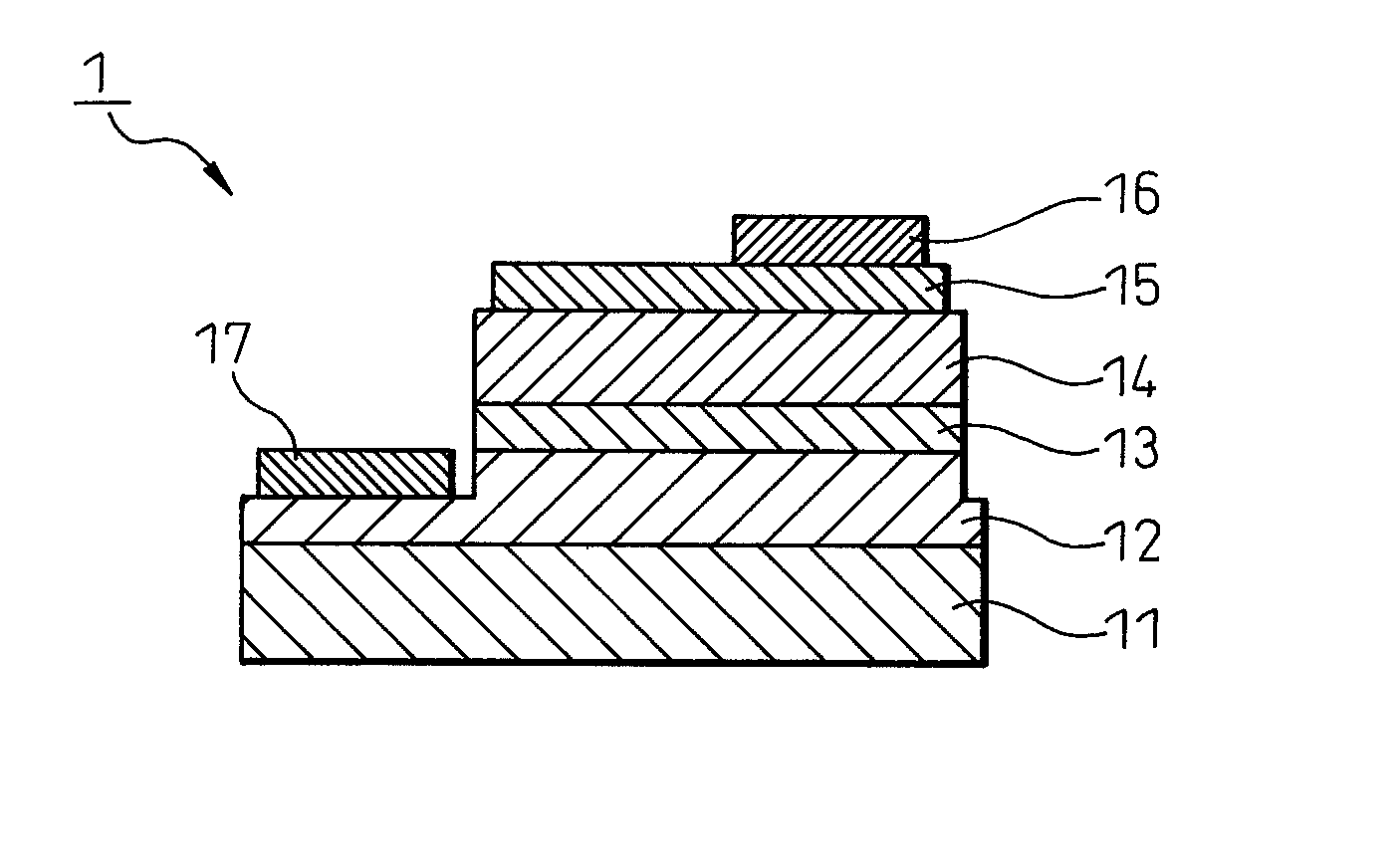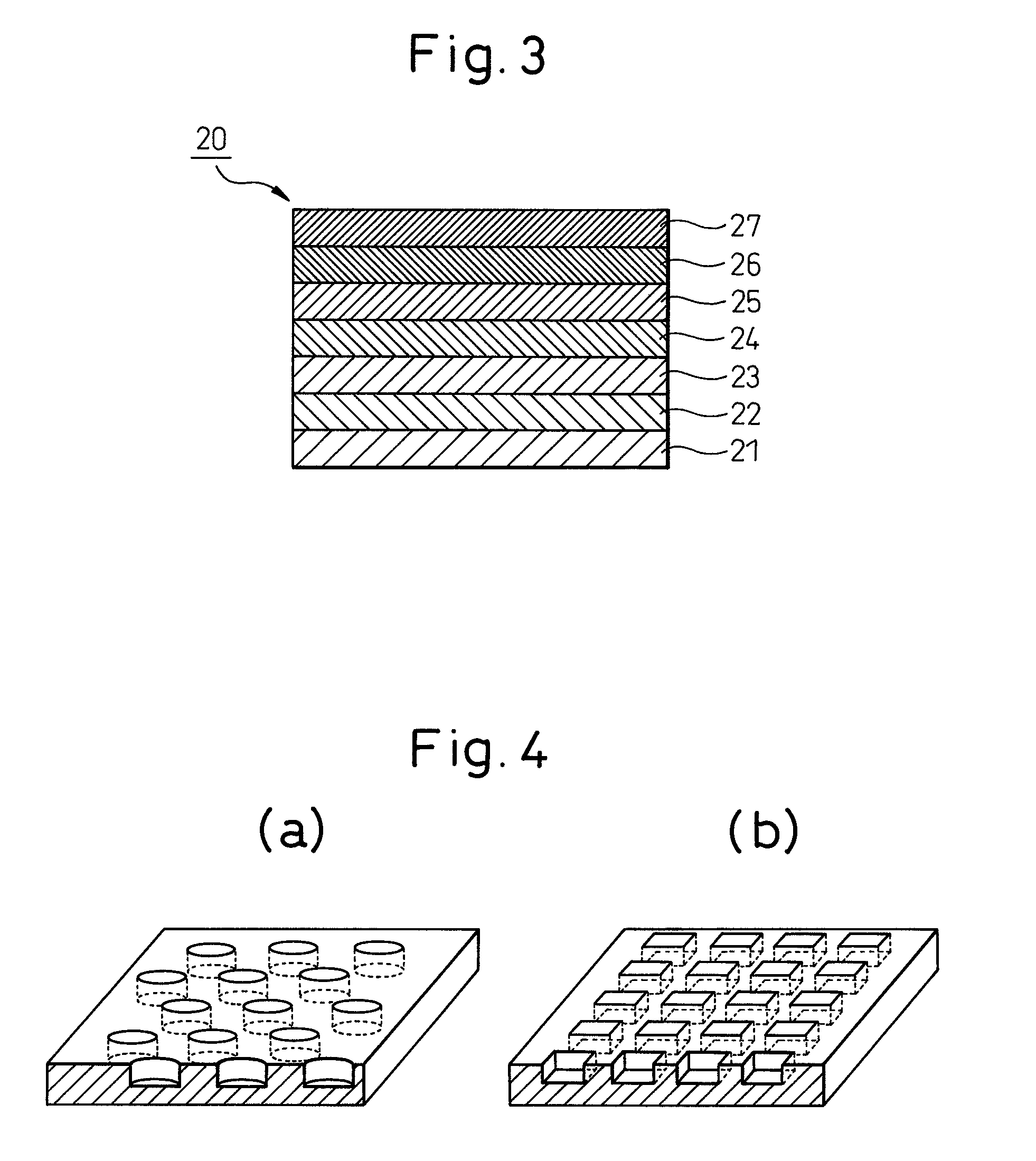Compound semiconductor light-emitting device and method for manufacturing the same
a light-emitting device and semiconductor technology, applied in semiconductor devices, semiconductor/solid-state device details, electrical apparatus, etc., can solve the problems of easy generation of burrs, difficult control, and light emitted in the light-emitting layer is not extracted to the outside, and achieve excellent etching properties, good yield, and excellent transparency
- Summary
- Abstract
- Description
- Claims
- Application Information
AI Technical Summary
Benefits of technology
Problems solved by technology
Method used
Image
Examples
example 1
Manufacture of Gallium Nitride-Based Compound Semiconductor Light-emitting Device
[0105]In FIG. 3, a schematic sectional view of a semiconductor wafer comprising a gallium nitride-based compound semiconductor layer manufactured so as to be used in gallium nitride-based compound semiconductor light-emitting device of this example is shown. In FIG. 1 and FIG. 2, a schematic sectional view and a plan view of the gallium nitride-based compound semiconductor light-emitting device manufactured in this example are shown. Description will now be made with reference to these drawings.
[0106]A stacked structure of a gallium nitride-based compound semiconductor wafer 20 was formed by sequentially forming, on a substrate 21 made of the c-surface (crystal (0001) face) of sapphire, an undoped GaN underlying layer (2 μm in thickness) 22, a Si-doped n-type GaN contact layer (2 μm in thickness, carrier concentration: 1×1019 cm−3) 23, a Si-doped n-type Al0.07Ga0.93N clad layer (12.5 nm in thickness, ca...
example 5
[0119]In the same manner as in Example 1, except that the surface that is not contacted with the p-type semiconductor layer of the IZO film is subjected to uneven working, a gallium nitride-based compound semiconductor light-emitting device was manufactured, and then evaluated in the same manner as in Example 1.
[0120]The uneven working step was performed before the heat treatment of the IZO film and wet etching was performed using the ITO-07 etching solution in the same manner as in the case of patterning of the IZO film. The uneven shape is a cylindrical recess shape measuring 2 μm in diameter and 150 nm in depth. Cylindrical recesses were arranged zigzag at a center pitch of 3 μm. Vf of the resulting gallium nitride-based compound semiconductor light-emitting device was 3.23 V, and Po was 13.5 mW.
examples 6 and 7
[0121]In the same manner as in Example 5, except that the depths of the cylindrical recesses were respectively adjusted to 200 nm and 250 nm, gallium nitride-based compound semiconductor light-emitting devices were manufactured, and then evaluated in the same manner as in Example 1.
[0122]In FIG. 10, a relation between the depth of the recesses on the surface of the IZO film, and Vf and Po of the gallium nitride-based compound semiconductor light-emitting device is shown. The abscissa denotes the depth (nm) of the recesses on the surface of the IZO film while the ordinate denotes Vf (V) of the gallium nitride-based compound semiconductor light-emitting device and Po (mW) of the gallium nitride-based compound semiconductor light-emitting device. When the depth of the recesses on the surface of the IZO film is 0, it shows that uneven working is not performed (Example 1).
[0123]As is apparent from the results shown in FIG. 10, as the depth of the recesses formed on the surface that is no...
PUM
 Login to View More
Login to View More Abstract
Description
Claims
Application Information
 Login to View More
Login to View More - R&D
- Intellectual Property
- Life Sciences
- Materials
- Tech Scout
- Unparalleled Data Quality
- Higher Quality Content
- 60% Fewer Hallucinations
Browse by: Latest US Patents, China's latest patents, Technical Efficacy Thesaurus, Application Domain, Technology Topic, Popular Technical Reports.
© 2025 PatSnap. All rights reserved.Legal|Privacy policy|Modern Slavery Act Transparency Statement|Sitemap|About US| Contact US: help@patsnap.com



